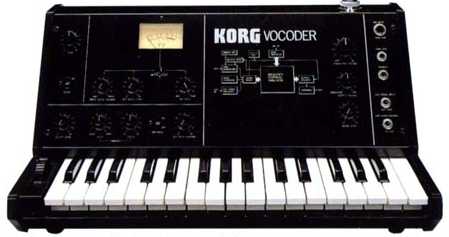The Korg VC-10 Mods

Most of you know the Korg VC-10 vocoder. It is sometimes said to be a not-so-good vocoder. I will however point out a few mods that will make it a real goodie. Now pay attention:
First of all, some facts about the VC-10: The vocoder has 20 (no more, no less) channels. I know this is sometimes a source of discussion, but this is the truth. I have the schematics and I have checked the hardware.
Furthermore, the sound source in the vocoder is actually 32 true VCO:s and 32 VCA:s (hence the 32 trimmers on the rear, for pitch adjustment).
Finally, there are 3 LFO:s for vibrato, to make the sound more dynamic and avoiding the organ/string machine sound.
1. The bias "mod":
If you think the VC-10 sounds dull and noisy, try and adjust the VCA bias. Turn your VC-10 around so you can read KORG on the backside. Now locate the trimmer hole near the right, lower corner. This is the bias trimmer, and it can be turned without any risk of damaging anything.
Adjust it while playing the keyboard and talking in the mic. You will find that there is a point where you can hear the generators without talking. Set the bias just below that point (that's in my taste, at least).
2. The carrier design flunk:
The VC-10 suffers from a rather coarse design flunk. At least in my opinion. The four highest channels, 17 to 20, have their carrier input connected NOT to the generator/noise/external mixer, but rather to noise only. The problem here is that this noise signal is attenuated by the generator/noise mixer, resulting in that there will be no carrier to channel 17 to 20 if you turn the generator/noise mixer knob to the generator only position! (which you may often do). Yes, the four highest channels will be quiet! Performing this mod will increase the speech recognition and add the missing edge to the sound.
Fix it: Locate and release PCB KLM-134 (the filter board). Locate the wire attached to header H3-1 (noise in). Cut or unsolder the wire. Now locate IC1 on the same board. Find pin 1 and follow the trace to channel 16. Connect from this point to the (now unconnected) corresponding point of channel 17.
You will see the channel numbers and the traces pretty easy on the PCB.
If you don't understand the instructions, I strongly recomment you don't put your soldering iron in your voc att all.
3. The high end lift mod:
The bias signal named under nr. 1 does not affect channels 15 - 20 (don't ask me why). Of course this can be fixed, to give you a brighter, more well defined sound and increase the effect of adjusting the bias.
The fix: On KLM-134, find IC5 pin 7 (bias). Follow this trace to R2414 (100k). Let's call this the bias signal.
Now locate Q115 (channel 15 VCA). Solder a 100k resistor between bias and the base of Q115 (R2315 is connected to the base). Then locate Q116 and solder a 100k resistor between bias and the base of Q116 (R2316 is connected to the base).
Channel 17 to 20 already have the 100k resistors you need, but they are connected to ground. Find R2417, R2418, R2419 and R2420. Connect them to bias instead of ground.
If you don't understand the instructions, I strongly recomment you don't put your soldering iron in your voc att all.
4. The sibilance mod:
The VC-10 has a simulator/mic balance knob in the output section. OK, but I want to mix in only the high end, the sibilance, of the speech. This mod replaces the mic signal in that mixer with one of the highest filter outputs.
The fix: Locate the simulator/mic balance pot. Cut the wire connected to H5-3 (mic signal). Solder a 150k resistor to the now unconnected pot terminal. To the other pin of the resistor, solder a new wire. Connect this wire to KLM-134, IC119 pin 7. (You may choose between IC117, 118 119 or 120 to your taste).
If you don't understand the instructions, I strongly recomment you don't put your soldering iron in your voc att all.
5. The ensemble mod:
I hate the ensemble on VC-10, Trident and PS-3100. They are way too fast. This mod slows down the ensemble speed into a more choral sound.
The fix: Locate and release KLM-136. Replace C45, C46 and C47 (27n) with 100n. Find C65, C66 and C67 (22n) and solder 100n in parallel with each of them. Done.
If you don't understand the instructions, I strongly recomment you don't put your soldering iron in your voc att all.
Good luck and enjoy your new vocoder!
DISCLAIMER: I will not take any responsibility for any damages resulting from performing the mods above.
